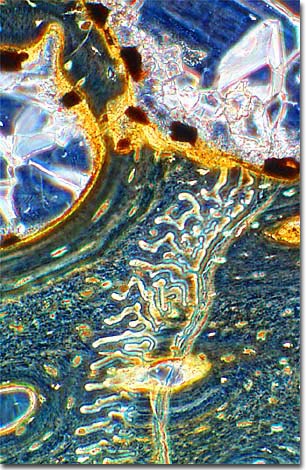Phase Contrast Image Gallery
Pleurodira:
Side-Necked and Snake-Necked Turtles
Transparent thin sections prepared from fossilized bone material often yield clues about the anatomy and physiology of now-extinct dinosaurs and other creatures. The micrograph below illustrates minerals that have formed in the fossilized bone from an ancient species of pleurodira.

Turtles (order Testudinata or Chelonia) are an ancient group of reptiles that once lived side by side with dinosaurs. Of the 16 groups of reptiles that have evolved over the past 310 million years, turtles are one of four groups that still exist today, with 260 species representing 13 families . The three other surviving groups of reptiles are the Crocodilia (alligators, caimans and crocodiles), Squamata (snakes and lizards), and Rhyncocephala (Tuataras). Turtles date back to the Triassic period, 245 to 208 million years ago, and they reached their greatest diversity by the end of the Cretaceous, 35 million years ago.
Today's turtles live in a variety of habitats ranging from deserts to oceans. Although they are abundant in the tropics, they are also commonly found in temperate regions and have been found near Arctic waters. Most species, including sea turtles, belong to one of the 11 families in the suborder Cryptodira. All of these turtles curl their necks in a vertical S when retracting their heads. The second group, the suborder Pleurodira only has two families, the side-necked and snake-necked turtles. These turtles curl their necks into a horizontal S-shape when they retract their heads.
Many species of turtles are known only through their fossils. The oldest and most primitive of these is Proganochelys. Equally as old as Proganochelys is the oldest known side-necked turtle, Proterochersis. Its presence in the late Triassic indicates that turtles had already separated into the two suborders that we know today.
BACK TO THE PHASE CONTRAST GALLERY
